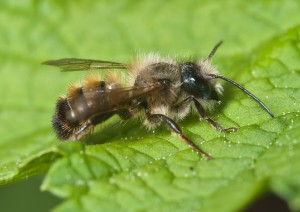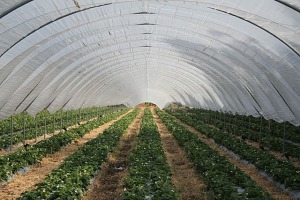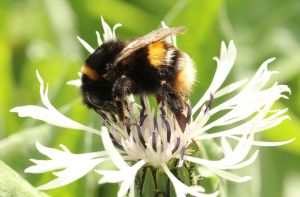A guest post by Erica K. Brockmeier
The following post is one of a series generated from research presented at the SETAC Europe Annual Meeting in Brussels, Belgium (7-11 May 2017). Each post features the latest research findings from SETAC scientists on emerging topics of interest.
Are pesticides hurting pollinators?
The widespread loss of honeybee populations in Europe and the reduced numbers of wild bees in other countries sparked concern among scientists, policymakers, and farmers all across the world. Recent research conducted on historical field data found a between the use of certain insecticides and changes in wild bee populations. This was especially true for species that are known to visit flowering crops like oil seed rape.

Bumblebee (Bombus sp.) on oil seed rape, England (cropped from original). Credit: Dean Morley, CC BY-ND 2.0.
While scientists have been looking in detail at how pesticides might be harmful to bees, there are still many questions on how to find the balance between protecting crops while ensuring the protection of bees and other pollinators. Managing both pesticide usage while mediating risks on wildlife populations continues to challenge scientists and policymakers.
Risk assessment is the primary tool that scientists use to address this challenge. A risk assessment is an evidence-based process that determines 1) how much of a toxic chemical can be found in a specific environment (the soil, water, or air) and how much an animal or person can come in contact with that chemical (called ‘exposure’), 2) the chemical is to an animal or person (hazard), and 3) the quantitative relationship between the two (risk). The three answers are used to calculate the risk a chemical poses in the environment.
In conducting bee and pollinator risk assessments, scientists are focused on logistical problems such as experimental set up, how much of a chemical a given pollinator will come in contact with, and determining the total toxicity of all of the pesticides currently in use. At the “New developments in ecotoxicology for the risk assessment of single and multiple stressors in insect pollinators: From the laboratory to the real world” held at the meeting, scientists highlighted new findings that can help policy makers choose the best course of action to ensure that pollinators are protected when pesticides are used.
New findings on the impacts of pesticides to pollinators
Are all pollinators affected by pesticides in the same way?

Red mason bee (Osmia bicornis). Credit: , .
To test whether different bee species respond to pesticides in the same way, David Spurgeon from the Center for Ecology and Hydrology exposed three bee species to several commercial pesticides and compared their responses. He exposed the European honeybee (Apis mellifera), the buff-tailed honeybee (Bombus terrestris), and the red mason bee (Osmia bicornis) to pesticides through their food and compared survival rates. Spurgeon and his group found that pesticide toxicity increased over time in all three species. This has implications for how scientists conduct regulatory toxicity tests on bees in the lab, and Spurgeon commented that scientists cannot rely on a single time point when trying to determine the overall risk from chemical exposure. This is especially relevant, he said, if the bees come in contact with the pesticide on a frequent and long-term basis.
Philipp Uhl from the University of Koblenz-Landau determined the toxicities of several pesticides and compared results between the European honeybee and the red mason bee. Because the European honeybee is the main test species for pesticide risk assessments in Europe, scientists are concerned that using only one pollinator species will make it difficult to accurately determine the risk to other species that may be more or less sensitive. Uhl found that the European honeybee was either more sensitive or had a similar sensitivity profile than the red mason to six of the tested pesticides. This means that using the European honeybee data to complete the risk assessments for these pesticides would be protective for other pollinator species. But for one set of pesticides, the European honeybee was less sensitive, and for certain pesticides there was a 100-times difference between the two species. Any risk assessments conducted using data generated from the honeybee would not provide results that would be protective to other species for these pesticides. Uhl concluded that these species-specific differences in chemical sensitivity should motivate scientists and policymakers to find better ways to test the most relevant species. Uhl commented that this data also indicates how chemicals should be used and what species of bees may be the first ones to be affected.
How do we design experiments to more accurately determine the effects of pesticides?

Credit: , .
Natalie Ruddle from Syngenta discussed the importance of experimental design for evaluating toxicity in species other than the European honeybee. Ruddle presented a field study that was designed to determine the impacts of a neonicotinoid (thiamethoxam) on the red mason bee. Since this pollinator is a solitary bee and does not have a central hive nor a queen, Ruddle and her collaborators worked to develop a field method that can measure the reproductive capacity of individual females. Their field setup relied on the use of long half-dome greenhouses where plants and bees were housed together (known as a “tunnel design”). While no negative effects were seen in the red mason bee when they were housed with pesticide-treated oilseed rape plants, Ruddle highlighted the continued challenges of designing these types of field experiments for solitary bee species, noting the need for consensus on how to set up such experiments.
Stefan Kimmel from Innovative Environmental Services, Ltd. discussed the dynamics of how bees are exposed to pesticides in an open field, also using the solitary red mason bee and pesticide-treated oilseed rape plants. Kimmel and colleagues sampled pollinators before and after pesticide application and looked at the amount of pesticides in the flower buds, pollen, nectar, the bee foragers themselves and the hive entrance. Kimmel found that there was a gradient in pesticide concentration, with higher levels in crops and lower but detectable levels found in the nesting sites.

Bombus sp. Credit: , .
At the end of the session, presenters and audience members discussed the current and future needs for pesticides and pollinators based on EU regulations. While tests conducted in open fields are not currently accepted by regulators, due to concerns about competing crops, Kimmel commented that there are advantages of open-field techniques because the setting more accurately represents how pollinators can become exposed to pesticides and avoids the potential for any harm caused by tunnel confinement.
What’s next for pollinators?
We still have a lot to learn about how bees and pollinators are impacted by pesticide use. But thanks to a better scientific understanding of the risks that pesticides can have on bees in agricultural settings, scientists and policymakers are working together, now more than ever before, on empirical and creative ways to address this global problem.
The latest science presented at the SETAC Brussels meeting highlights how researchers, government institutions, regulators, and agrochemical companies are working together to find the best ways to protect pollinators. SETAC will also continue to be a place for scientists to work together with the Pollinators interest group now being developed within SETAC.

Glyphosate has been long touted by industry as being a ‘safer’ herbicide, because its mode of toxic action is by affecting the shipmate pathway in plants. ‘Human’ do not have a shipmate pathway to disrupt. However, our gut biome does have organisms growing in there that DO utilize the same pathway. Does glyphosate harm biome function?
Do pollinators have similar gut biome sensitivities that could be adversely affected?
Spell check struck again. Above ‘shipmate’ should read Shikamate.